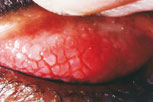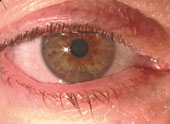- A-
- A+

What are the mains forms of ocular allergies?
Allergic conjunctivitis

The most common ocular allergy in adults as well as in children is the Allergic conjunctivitis. It manifests itself as a hypersensitivity reaction against environmental allergen. For a better understanding of the infection, you have to be aware that it concerns conjunctiva, which is the membrane surrounding the white of the eye.
We distinguish different types of allergic conjunctivitis. Seasonal allergic conjunctivitis is due to hypersensitivity against pollen. It is characterized by spring and early-summer allergic episodes. Symptoms disappearing the rest of the year.
On the other hand, Perennial allergic conjunctivitis mainly affects adults. It is continuously occurring and, as a matter of fact, is not associated with seasons change. Allergens are particularly involved in this type of conjunctivitis.
This reactions to the environment are also the cause of atopic conjunctivitis. It usually appears with general signs of atopy like eczema or asthma
Keratitis
Keratoconjunctivitis is also a type of ocular allergic reactions. Less frequent, this type of infections can be responsible for more severe ocular damages.
Vernal Keratoconjunctivitis is a serious form of conjunctivitis in children. It affects essentially the young boys, from 4 until puberty.
Five times out of ten, it is associated with another type of ocular allergy and three patients out of ten have a history of atopy. This is a hypersensitivity reaction to environmental factors, but genetic data could also be responsible for that pathology.
Eyelids allergies

Allergies can also affect eyelids. It is more frequently a palpebral eczema, but it is not unusual to see multiple disease mechanisms. They are responsible for chronic blepharitis (eyelids inflammation) in adults, in which allergy plays a huge part.
More information about allergy :


